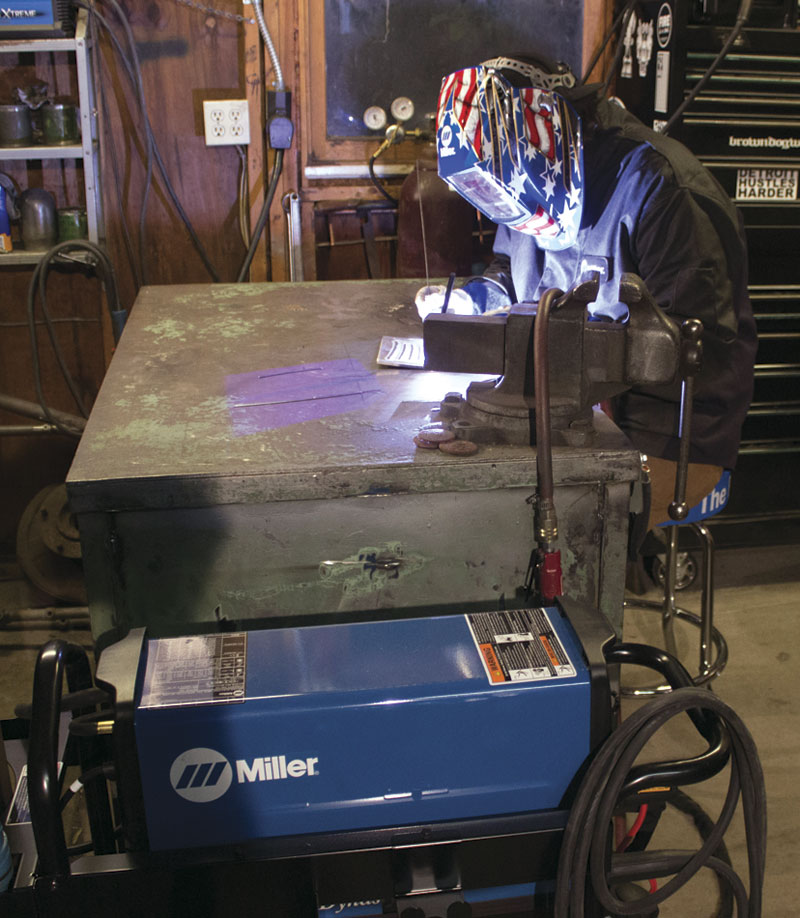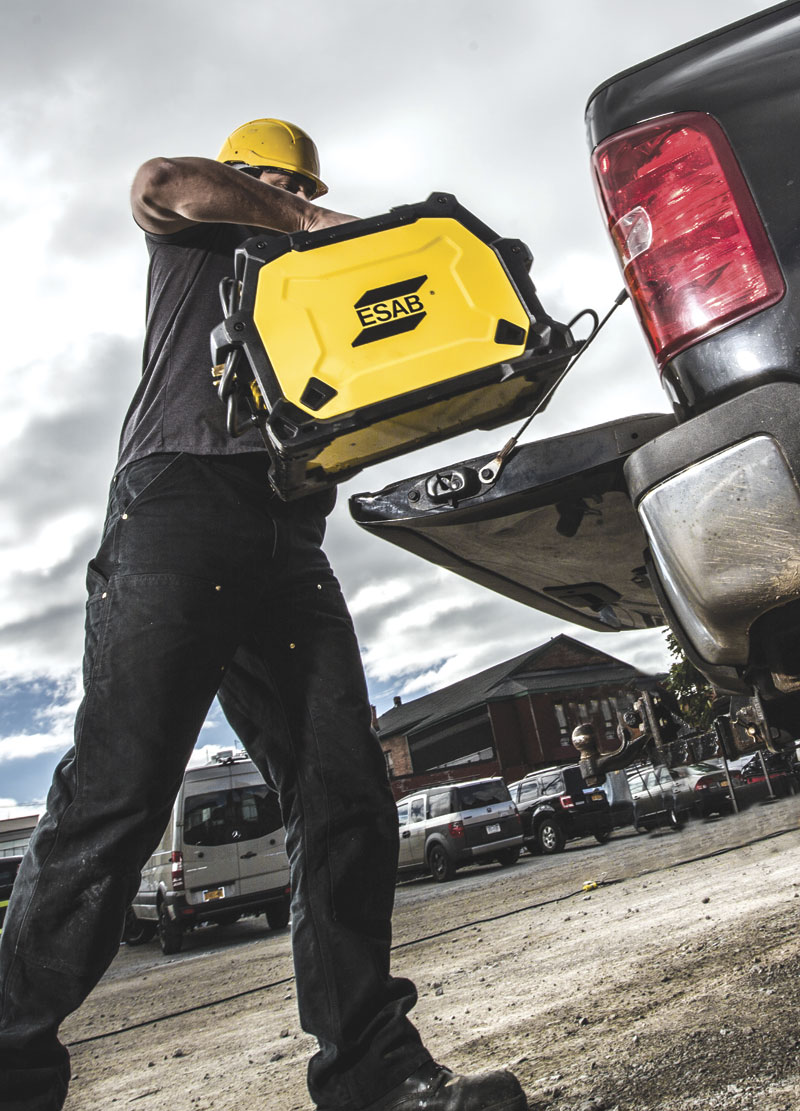by Mary Scianna
Technology advances are making portable welding systems faster, smarter and easier to use
Welders who handle portable welding equipment face unique challenges. Whether youʼre a welder using portable units in a shop, offsite on a construction site or in a remote and isolated location on pressure pipes, you need a compact, lightweight but durable and reliable system with flexibility to change weld parameters on-the-fly and respond to conditions in your environment and, perhaps most importantly, you want it to be easy to use.
Part of the need for easier-to-use equipment is being driven by the North American-wide shortage of skilled welders, say suppliers like Miller.
Andrew Pfaller is a product manager with Miller Electric who oversees TIG welding system solutions.
“The younger generation isnʼt getting into welding in the same numbers as in the past, so itʼs driven a shortage of skilled welders. Those that do come into the industry havenʼt had much exposure to welding so they often struggle with how to set up a machine. Itʼs a big hurdle for welding companies and for the welding equipment manufacturers.”
Welding equipment manufacturers are responding to this by introducing easier to use interfaces featuring fewer adjustment parameters on the front panel with options to access a second advanced level to change multiple parameters. And some have introduced features that adjust select parameters such as voltage, automatically.
Thereʼs also been a bigger focus on ergonomics with suppliers introducing lighter weight portable units, new designs with better grips and handles, and wireless technology to eliminate control cords that typically get tangled and damaged with welding lead cords in some welding operations such as TIG.
“We’ve seen some customers, and have also conducted case studies of welders using our wireless technology, and on average, people have experienced 10 to 15 minutes of time savings a day just from not having to wind a cord and untangle it and then wind it again at the end of a day. Thatʼs a big saving, about a week worth of pay for a welder,” says Pfaller.
Smarter and faster
The digital evolution in manufacturing is making its way into the welding realm.
“We see tremendous value for Industry 4.0 for portable welding,” says Anders Lindh, director of strategy for ESAB based in Goteborg, Sweden. “If youʼre in the field and you encounter an issue with your machine, if itʼs connected to a network, you can run diagnostics, generate advice on how to troubleshoot based on the data in the system, order spare parts automatically, and via a GPS system, the welding supplier can have the knowledge of where the welder is located and send the parts.”
ESAB is one step closer to this digital reality with the introduction of its WeldCloud, launched at FABTECH Chicago in November 2015. WeldCloud is an online data management platform that can be retrofit on existing ESAB welding systems, such as the Aristo MIG semi-automatic, Aristo MIG 5000iR robotic and LAF/TAF sub arc models.
While not currently being used for portable welding, Lindh says it has the functionality to make it useful in the field, particularly for fleet management.
“Our WeldCloud-enabled machines are equipped with GPS units, WiFi and Bluetooth, so for large rental companies or even welders in shipyards that use portable systems, you can see what different welders are doing, collect data for all the machines in the same WeldCloud and then manage that data to help improve welding processes.”
WeldCloud and similar Industry 4.0 tools are still in their infancy for portable welding, in part because people have been hesitant to embrace them.
 “Weʼve seen a broad adaption of Industry 4.0 in industry, particularly with automation and robotics, and we see the value in the portable welding category but it has not taken off yet and thatʼs because itʼs a value sell and many donʼt see the value in bringing this technology into the portable welding area, but there is value in it but also high costs and thereʼs work to do to drive down costs–and thatʼs ongoing,” says Roul Kierkels, business project leader equipment with ESAB.
“Weʼve seen a broad adaption of Industry 4.0 in industry, particularly with automation and robotics, and we see the value in the portable welding category but it has not taken off yet and thatʼs because itʼs a value sell and many donʼt see the value in bringing this technology into the portable welding area, but there is value in it but also high costs and thereʼs work to do to drive down costs–and thatʼs ongoing,” says Roul Kierkels, business project leader equipment with ESAB.
Current technology allows welders to monitor welding process parameters, set thresholds and manage data for improvements. Some, like Miller Electric, call it “welding intelligence” solutions and offer information management software such as Insight Core and Insight Centerpoint. The company now offers this software to some of its portable welding systems, including the Dynasty 280 DX TIG welder. InsightCore monitors, collects and transmits electronic weld data to any Web-connected device. Insight Centerpoint is a more advanced offering that provides real-time operator feedback and process control.
Another example of smart portable welding systems is ESABʼs Rebel. Equipped with the companyʼs sMIG (“smart MIG”) function, the multi-process system enables users to begin MIG welding with a stable arc just by setting metal thickness and wire diameter; thereʼs no need to enter information for shielding gas mix. The smart control system automatically adapts to any popular steel, stainless, chrome-moly or aluminum filler metal/gas combination.
“The Rebel EMP 215ic is the most incredible go-anywhere, weld-anything machine on the market,” says Doug Smith, ESAB product business manager for arc equipment. “As just one example, no other small, integrated welder can run a E6010 electrode, much less run it well on 120V. The Rebel offers outstanding all-process arc performance because we enhanced the control algorithms from our industrial systems, gathered input from real world welders and then incorporated that knowledge into the Rebel design.”
The sMIG smart control monitors the operatorʼs technique and continuously adapts the MIG output to provide a stable arc and superior, repeatable welds. “sMIG takes smart to a level never-before-seen in the industry,” says Smith. “Experienced welders become productive more quickly, and novice welders start producing quality welds in less time. The sMIG feature takes away the doubt of welding with incorrect settings and so users can focus on good gun technique. Rebel gives users confidence to weld anywhere with a ready-to-weld package.”
What’s old is new
When it comes to cross-country pipeline welding, you need a reliable welder.
“Pipeline welders have a tough job and are tested every day,” says Bruce Clark director of marketing and export sales for Lincoln Electric Co. of Canada. “Every inch of a pipeline is visually inspected and if there are two repairs, these welders can be let go because the cost of a repair is very high. If a weld canʼt be repaired and has to be cut out, that process and subsequent welding can cost upwards of $50,000.”
Clark has been selling pure DC generator pipeline welders for more than 30 years. In fact, Lincoln has been manufacturing these pipeline welders since the 1930s at its East Toronto manufacturing facility and today, it is the only Lincoln facility in the world that manufactures multiple models of the machines for export around the globe.
While the technology has been in existence for a long time, the machines continue to be in high demand, says Clark.
 Clark says Lincoln is the only manufacturer to offer these pure DC generator welders. Other industry manufacturers have backed away from this technology because it is expensive, says Clark. The all-copper windings are hand-wound and typically take an operator 45 minutes to produce just one armature, “but the output is so stable for critical welding applications like pipeline, that itʼs the welding machine of choice for pipeline welding.”
Clark says Lincoln is the only manufacturer to offer these pure DC generator welders. Other industry manufacturers have backed away from this technology because it is expensive, says Clark. The all-copper windings are hand-wound and typically take an operator 45 minutes to produce just one armature, “but the output is so stable for critical welding applications like pipeline, that itʼs the welding machine of choice for pipeline welding.”
He adds that the pure DC generator machines have a “tremendous record” in the field.
“Pipeline welders work ten hour days and theyʼre under the hood for long periods of time, so they need a reliable, stable unit.” Lincolnʼs pure DC generator pipeline welders typically go much farther than other pipeline welders, claims Lincoln. Its SAE-300 MP portable welder is designed with a 60.6 L (16-gal) tank that Lincoln says is close to 50 per cent larger than others on the market and means longer run times, improved efficiency and higher cost savings.
The latest changes to these portable welders is flexibility. Lincoln has introduced multi-process models that allow for stick, TIG and flux cored welding in one machine. A recent example is the SAE-300 MP multi-process engine-driven welder, powered by a hand-built pure DC generator. The all-copper windings and flat DC output ensure a smooth and stable arc to help reduce defects and avoid costly cutouts and repairs.
The SAE-300 MP is equipped with dual continuous current control to handle the variations in pipe joints. It also features “Temperature Stabilization” which eliminates the need for operators to make adjustments based on ambient conditions or a warm-up period.
Suppliers says portable welders will continue to evolve as builders focus on technologies such as software and controls to develop smarter, but easier to use products. SMT
